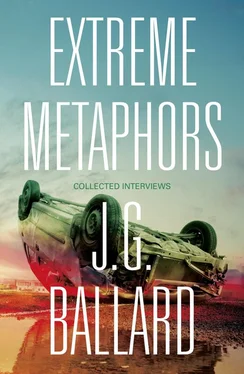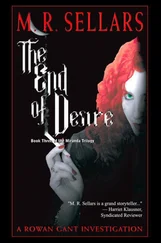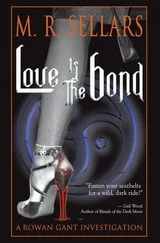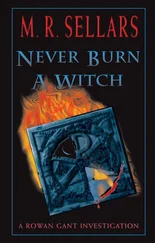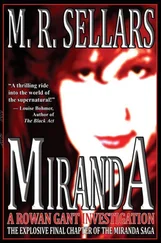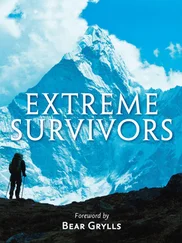BALLARD:Yes, I don’t see them as ‘characters’ in the conventional sense of the term; they are aspects of certain character situations. They haven’t got the same name, but they have variations of the same name.
MACBETH:I remember a case of this myself. There’s a character called Tallis in one story and a character called Traven in another, and they seem to have something in common.
BALLARD:In effect they’re the same character, but their role in the stories is not to be characters in the sense that Scobie, let’s say, in [Graham Greene’s] The Heart of the Matter , or any other characte r in the retrospective novel is a character, an identifiable human being rather like those we recognise among our friends, acquaintances and so on.
MACBETH:Could we take a specific case from ‘You and Me and the Continuum’ here – Dr Nathan, who seems to be, as far as the reader or listener can put a label to him, a psychiatrist? Could you elaborate on what his function is in the story?
BALLARD:He serves the role of analysing the events of the narrative from the point of view of the clinical implications. He represents the voice of reason, whatever the limitations of that term might be.
MACBETH:The central ‘consciousness’ or area of character in the story is sometimes a composite one in some ways; somebody who has gone through an extreme situation or a psychological crisis or a public crisis; somebody in a mental hospital who might also be the pilot of a crashed bomber; and so on. What are you trying to do with this sort of merged consciousness?
BALLARD:All these characters exist on a number of levels. I feel that the fictional elements in experience are now multiplying to such a point that it is almost impossible to distinguish between the real and the false, that one has many layers, many levels of experience going on at the same time. On one level one might have the world of public events, Cape Kennedy, Vietnam, political life; on another level the immediate personal environment, the rooms we occupy, the postures we assume. On a third level the inner world of the mind. All these levels are, as far as I can see them, equally fictional, and it is where these levels interact that one gets the only kind of valid reality that exists nowadays. The characters in these stories occupy positions on these various levels. On the one hand, a character is displayed on an enormous billboard as a figment in a Cinemascope epic; on another level he’s an ordinary human being moving through the ordinary to-and-fro of everyday life; on a third level he’s a figment in his own fantasies. These various aspects of the character interact and produce the main reality of the fiction.
MACBETH:Yes, I think this element of layers also comes out in the density of some of the stories – the way you seem to link together references from a wide variety of fields. I quote if I may, as an interesting example, one passage from ‘You and Me and the Continuum’, which is the kind of passage that recurs in a number of these stories:
Kodachrome. Captain Kirby, MI5, studied the prints. They showed: (1) a thick-set man in an Air Force jacket, unshaven face half-hidden by the dented hat-peak; (2) a transverse section through the spinal level T-12; (3) a crayon self-portrait by David Feary, 7-year-old schizophrenic at the Belmont Asylum, Sutton; (4) radio-spectra from the quasar CTA 102; (5) an antero-posterior radiograph of a skull, estimated capacity 1500 cc.; (6) spectro-heliogram of the sun taken with the K line of calcium; (7) left and right handprints showing massive scarring between second and third metacarpal bones. To Dr Nathan he said: ‘And all these make up one picture?’
BALLARD:Exactly. They make up a composite portrait of this man’s identity. In this story I was examining the particular role that a twentieth-century messiah might take, in the context of mid-twentieth-century life. I feel that he would reappear in a whole series of aspects and relationships, touching an enormous range of events; that he wouldn’t have a single identity, in the sense that Jesus had – he would have a whole multiplex of contacts with various points.
MACBETH:I see this, but why do certain particular kinds of imagery recur? You may claim that these are the appropriate and inevitable ones, but you do seem as a writer to have a sort of ‘thing’ about certain kinds of imagery; for example, certain kinds of landscape – landscapes which involve sand keep recurring. Can you give any further explication of why these come in?
BALLARD:I think that landscape is a formalisation of space and time, and the external landscapes directly reflect interior states of mind. In fact, the only external landscapes which have any meaning are those which are reflected, in the central nervous system, if you like, by their direct analogues. Dali said somewhere that mind is a state of landscape, and I think this is completely true.
MACBETH:You do literally, in many of these stories, draw connections between pictures of parts of the human body and certain landscapes, don’t you?
BALLARD:Yes. In the story ‘You: Coma: Marilyn Monroe’ I directly equate the physical aspect of Marilyn Monroe’s body with the landscape of dunes around her. The hero attempts to make sense of this particular equation, and he realises that the suicide of Marilyn Monroe is, in fact, a disaster in space-time, like the explosion of a satellite in orbit. It is not so much a personal disaster, though of course Marilyn Monroe committed suicide as an individual woman, but a disaster of a whole complex of relationships involving this screen actress who is presented to us in an endless series of advertisements, on a thousand magazine covers and so on, whose body becomes part of the external landscape of our environment. The immense terraced figure of Marilyn Monroe stretched across a cinema hoarding is as real a portion of our external landscape as any system of mountains or lakes.
MACBETH:Are you aware of deliberately using surrealism as references in these stories? Quite often you refer to Dali in particular and sometimes Ernst, and sometimes to real pictures by them. How far is there a direct connection with those pictures and the events or descriptions in the stories?
BALLARD:The connection is deliberate, because I feel that the surrealists have created a series of valid external landscapes which have their direct correspondences within our own minds. I use the phrase ‘spinal landscape’ fairly often. In these spinal landscapes, which I feel that painters such as Ernst and Dali are producing, one finds a middle ground (an area which I’ve described as ‘inner space’) between the outer world of reality on the one hand, and the inner world of the psyche on the other. Freud pointed out that one has to distinguish between the manifest content of the inner world of the psyche and its latent content. I think in exactly the same way today, when the fictional elements have overwhelmed reality, one has to distinguish between the manifest content of reality and its latent content. In fact the main task of the arts seems to be more and more to isolate the real elements in this goulash of fictions from the unreal ones, and the terrain ‘inner space’ roughly describes it.
MACBETH:Yes, one often has the sense that certain of the events in these stories, insofar as they are ‘events’, might be taking place within, particularly, a Dali painting. I also have the sense in reading these stories that there’s a kind of hallucinatory vividness and clarity about the descriptions which remind me of certain techniques used by the cinema in the 1960s. Are you aware of being influenced by films at all?
Читать дальше
